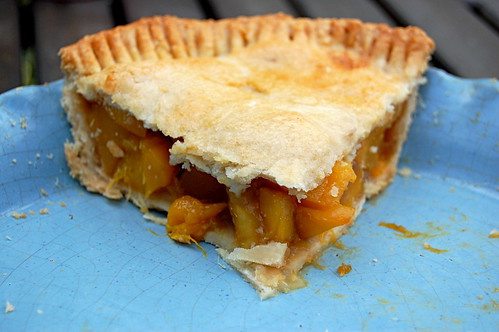 We're taking a break from our usually scheduled Middle Eastern fare for something quite deserving of your attention: Mango Pie! I'll admit that I would not have thought of this myself, but a certain someone I know is quite obsessed with pie, and rather enamored of mangos, and using the five-year-old logic that things you like must go well together, thus begat mango pie.
We're taking a break from our usually scheduled Middle Eastern fare for something quite deserving of your attention: Mango Pie! I'll admit that I would not have thought of this myself, but a certain someone I know is quite obsessed with pie, and rather enamored of mangos, and using the five-year-old logic that things you like must go well together, thus begat mango pie.And though mangos may not be traditional in pie, they certainly stand up perfectly to the short-crust treatment. They were soft and sweet without being runny or mushy. Looking at the price and labor of using fresh mangos, I decided to go for frozen, which turned out the be an excellent economical choice. The only thing I would say about frozen mangos is to thaw them and check them over for under-ripe pieces. Our bags had a few firm pieces that never softened up in baking, so I wished I had gone over the fruit first. Of course, fresh mangos would be even better I imagine. The pie is spiked with a bit of rum ad ginger, and we served it with an excellent homemade coconut ice cream for the a la mode treatment.
Mango Pie
If using frozen mangos you'll need 2 bags of frozen. Thaw them, check over for any too-firm pieces, and slice in half any of the larger segments. Then use as below.
dough for a double-crust pie
4 1/2 cups cubed mango
2/3 cup brown sugar
3 tbl cornstarch
2 tbl dark rum
1 tbl diced crystallized ginger
optional:1 egg for egg wash
1. Preheat oven to 425F. Roll out pie crusts and refrigerate.
2. Combine filling ingredients (mango, sugar, cornstarch, rum, ginger) in a large bowl.
3. Fit pie crust into pan, add filling, top with second pie crust and trim edges. Cut slits for vents on top crust. If desired, beat egg with a tablespoon of water and brush over crust.
4. Bake for 20 minutes at 425F, then lower oven temperature to 375F and bake for 30 minutes.











